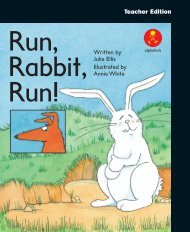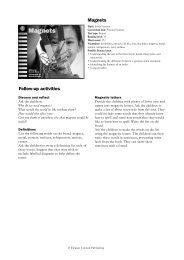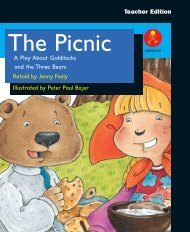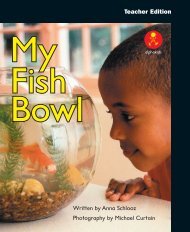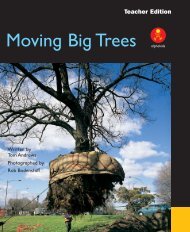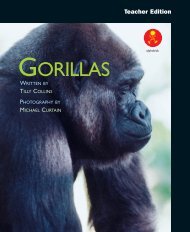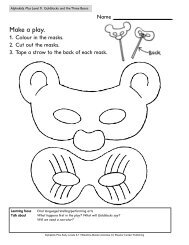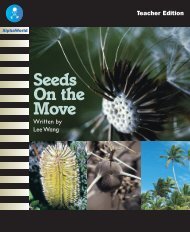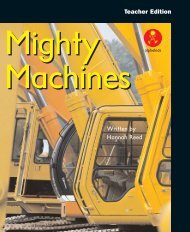Animals of the African Grasslands
Animals of the African Grasslands
Animals of the African Grasslands
Create successful ePaper yourself
Turn your PDF publications into a flip-book with our unique Google optimized e-Paper software.
<strong>Animals</strong> <strong>of</strong> <strong>the</strong> <strong>African</strong> <strong>Grasslands</strong> Pages 4–7PredictThis is <strong>the</strong> introduction. This introduction says thatgrasslands cover large parts <strong>of</strong> Africa.Point out <strong>the</strong> map <strong>of</strong> Africa and <strong>the</strong> amount <strong>of</strong> grasslandsshaded.Look at <strong>the</strong> photos on this page. What do you thinkgrasslands are like? What types <strong>of</strong> animals will call <strong>the</strong>grasslands <strong>the</strong>ir home?Turn to page 6.The next chapter is about plant-eaters. This page says that<strong>the</strong> grasslands <strong>of</strong> Africa feed millions <strong>of</strong> animals. How would<strong>the</strong>re be enough food for all <strong>the</strong> different types <strong>of</strong> animals?How would <strong>the</strong>y share <strong>the</strong> plants?Read to <strong>the</strong> end <strong>of</strong> page 7.ReflectTell me in your own words something that you discoveredabout animals that live on <strong>the</strong> <strong>African</strong> grasslands?How do <strong>the</strong> many types <strong>of</strong> plant-eaters share <strong>the</strong> plants?Observe and supportDoes <strong>the</strong> child check what she or he read with <strong>the</strong>phonic information on <strong>the</strong> page?How did you know that word was ‘antelope’? What didyou check at <strong>the</strong> start <strong>of</strong> <strong>the</strong> word? What did you lookfor at <strong>the</strong> end <strong>of</strong> <strong>the</strong> word? What else did you check?4
<strong>Animals</strong> <strong>of</strong> <strong>the</strong> <strong>African</strong> <strong>Grasslands</strong> Pages 8–11PredictPlant-eaters that eat grass are called grazers. All parts <strong>of</strong><strong>the</strong> grasses are grazed by different animals. What would be<strong>the</strong> different parts <strong>of</strong> <strong>the</strong> grasses?Gazelles eat <strong>the</strong> new shoots <strong>of</strong> different grasses. Warthogsdig in <strong>the</strong> ground with <strong>the</strong>ir feet, tusks and mouths. Whatpart <strong>of</strong> <strong>the</strong> grasses do you think <strong>the</strong>y eat?Turn to page 10.Large animals that eat <strong>the</strong> leaves and stems <strong>of</strong> bushes andtrees are called browsers.Look at <strong>the</strong> photos on this page. What do you think kudu,giraffes and elephants eat?Read to <strong>the</strong> end <strong>of</strong> page 11.ReflectWhat does ‘graze’ mean?What part <strong>of</strong> <strong>the</strong> grasses do gazelles, warthogs, wildebeestand buffalo eat?Do elephants and giraffes browse on <strong>the</strong> same part <strong>of</strong> <strong>the</strong>trees? How do you know?Observe and supportAsk a child to read aloud to you while <strong>the</strong> o<strong>the</strong>rchildren are reading silently.Can <strong>the</strong> child read <strong>the</strong> text fluently?Try to make it sound as if you were talking to someone.6
<strong>Animals</strong> <strong>of</strong> <strong>the</strong> <strong>African</strong> <strong>Grasslands</strong> Pages 12–15PredictMeat-eating animals eat plant-eating animals. These meateatersare ei<strong>the</strong>r predators or scavengers. What do youthink a predator does? What do you think a scavengerdoes?Turn to page 14.This section is about predators. When leopards hunt <strong>the</strong>yhide in bushes and tall grass to watch <strong>the</strong>ir prey. Leopardsare very powerful and carry <strong>the</strong>ir prey into trees so o<strong>the</strong>rpredators cannot reach <strong>the</strong>m.Look at <strong>the</strong> photos <strong>of</strong> <strong>the</strong> cheetah. How do you think <strong>the</strong>ycatch <strong>the</strong>ir prey?Read to <strong>the</strong> end <strong>of</strong> page 15.ReflectDo predators and scavengers hunt for food in <strong>the</strong> same way?Are <strong>the</strong>y in competition with each o<strong>the</strong>r? How do you know?What is special about <strong>the</strong> cheetah? Why can it run so fast?Observe and supportCan <strong>the</strong> child explain <strong>the</strong> meaning <strong>of</strong> <strong>the</strong> scientificlanguage used in <strong>the</strong> book?What do you think prey means?What is <strong>the</strong> difference between a predator and ascavenger?8
<strong>Animals</strong> <strong>of</strong> <strong>the</strong> <strong>African</strong> <strong>Grasslands</strong> Pages 16–19PredictDiscuss <strong>the</strong> heading and subheading on this page.Look at <strong>the</strong> photo <strong>of</strong> <strong>the</strong> lion. Lions <strong>of</strong>ten hunt in a smallgroup called a pride. The pride shares <strong>the</strong> kill. Look at <strong>the</strong>photo <strong>of</strong> <strong>the</strong> <strong>African</strong> hunting dogs. Do you think <strong>the</strong>y hunt ingroups as well? Why?Turn to page 18.This section is about scavengers. Scavengers feed onanything <strong>the</strong>y find on <strong>the</strong> grasslands. Look at <strong>the</strong> photos <strong>of</strong><strong>the</strong> vultures. What can you see? How would <strong>the</strong>y find <strong>the</strong>irfood? Hyenas have <strong>the</strong> most powerful jaws <strong>of</strong> all <strong>the</strong>scavengers. What would <strong>the</strong>y use <strong>the</strong>m for?Read to <strong>the</strong> end <strong>of</strong> page 19.ReflectTell me in your own words how <strong>African</strong> hunting dogs huntfor food?Tell me something interesting you discovered aboutscavengers?Observe and supportCan <strong>the</strong> child interpret <strong>the</strong> text?Why do some predators, like <strong>the</strong> lion and <strong>the</strong> <strong>African</strong>hunting dog, hunt <strong>the</strong>ir prey in groups?10
<strong>Animals</strong> <strong>of</strong> <strong>the</strong> <strong>African</strong> <strong>Grasslands</strong> Pages 20–23PredictDiscuss <strong>the</strong> heading and subheading on this page.Most large plant-eating animals live in big groups calledherds. Why do you think <strong>the</strong>se animals live and travelin a herd?Look at <strong>the</strong> photo <strong>of</strong> <strong>the</strong> wildebeest and zebra. Why woulddifferent types <strong>of</strong> animals travel toge<strong>the</strong>r?Turn to page 22.Look at <strong>the</strong> photo <strong>of</strong> <strong>the</strong> gazelle. What do you notice aboutits eyes? Why would big eyes on <strong>the</strong> side <strong>of</strong> <strong>the</strong>ir head help<strong>the</strong>m keep safe from predators?Read to <strong>the</strong> end <strong>of</strong> page 23.ReflectWhy is it safer to live and travel in a herd? Why do differentanimal herds travel toge<strong>the</strong>r?How do plant-eaters keep <strong>the</strong>mselves safe from predatorswhile <strong>the</strong>y are feeding?Observe and supportCan <strong>the</strong> child explain <strong>the</strong> use <strong>of</strong> headings andsubheadings in <strong>the</strong> text?Why does <strong>the</strong> author use headings and subheadings?What is <strong>the</strong>ir purpose?12
<strong>Animals</strong> <strong>of</strong> <strong>the</strong> <strong>African</strong> <strong>Grasslands</strong> Page 24PredictThis is <strong>the</strong> conclusion. It tells us that most <strong>of</strong> <strong>the</strong> animals <strong>of</strong><strong>the</strong> <strong>African</strong> grasslands are plant-eaters. It also says that<strong>the</strong>y eat different parts <strong>of</strong> nearly every kind <strong>of</strong> plant on <strong>the</strong>grasslands. What do you think it will say about meat-eaters?Read to <strong>the</strong> end <strong>of</strong> page 24.ReflectAre <strong>the</strong>re more plant-eaters or meat-eaters? How do youknow?Tell me something you have learned about animals <strong>of</strong> <strong>the</strong><strong>African</strong> grasslands.Observe and supportCan <strong>the</strong> child interpret what <strong>the</strong> author might mean?Why do all grassland animals depend on plants forfood?14
After readingBeing a meaning makerEncourage <strong>the</strong> children to support<strong>the</strong>ir answers with evidence from<strong>the</strong> book as <strong>the</strong>y discuss <strong>the</strong>sequestions:What is a plant-eater?How do plant-eaters work toge<strong>the</strong>rto survive?What is a meat-eater?What is <strong>the</strong> difference betweenpredators and scavengers?Why do all <strong>the</strong> animals that live on<strong>the</strong> <strong>African</strong> grasslands depend onplants to survive?Being a code breakerExplore <strong>the</strong> following languagefeatures:• Adjectives: big, coarse, flexible,great, long, powerful, short, tall,thick, top, wide• Plurals: animals, buffalo,cheetahs, elephants, grasslands,gazelles, kudu, leaves, leopards,shrubs, stems, trees, wildebeest,warthogsBeing a text userRefer back to <strong>the</strong> meat-eater/planteatersort that children did afterdiscussing <strong>the</strong> contents page. Invitechildren to change and addinformation.Are <strong>the</strong>re o<strong>the</strong>r <strong>African</strong> animals wehave discovered from reading thisbook? Are <strong>the</strong>y meat-eaters orplant-eaters?Do we need to make changes to ouroriginal animal sort? Why?Being a text criticTell me about <strong>the</strong> information in<strong>the</strong> story that you were mostinterested in?Was <strong>the</strong>re anything about this bookthat helped you to understand <strong>the</strong>information better? What was it?16
Responding to textThe children could complete aninformation retrieval chart basedon <strong>the</strong> book. Retrieval charts help tocategorise information and provide avisual summary <strong>of</strong> <strong>the</strong> text. The retrievalchart for this book could look like <strong>the</strong>one below.The children could complete apicture facts activity. Have <strong>the</strong>children re-read <strong>the</strong> conclusion toge<strong>the</strong>rand draw a picture to represent eachpiece <strong>of</strong> information found in it. Thechildren could draw plants, a giraffeeating branches, a warthog eating roots, acheetah running after its prey and avulture eating a dead zebra.<strong>Animals</strong> <strong>of</strong> <strong>the</strong> <strong>African</strong> <strong>Grasslands</strong> byJames TaliaDiscuss what <strong>the</strong> children believean adjective to be. The childrencould work in pairs to find and highlight<strong>the</strong> adjectives on a photocopied page <strong>of</strong><strong>the</strong> book. Have <strong>the</strong> children share andjustify <strong>the</strong>ir choices with <strong>the</strong> class.What type <strong>of</strong> words are adjectives?What do adjectives do to a sentence?Writing linksLook at an enlarged photo <strong>of</strong> an <strong>African</strong>animal. Discuss its features and generatea list <strong>of</strong> adjectives to describe it. Thenmodel writing an interesting sentenceabout this animal using as manyadjectives as you can.Provide pictures <strong>of</strong> <strong>African</strong> animals. Thechildren could select one and write <strong>the</strong>irown sentences describing <strong>the</strong> uniquefeatures <strong>of</strong> that animal. Display <strong>the</strong>sentences with <strong>the</strong> picture.Animal Movement Food Meat/ plant eaters? What type <strong>of</strong>meat-eater/plant-eater?Gazelles Long muscular legs New shoots <strong>of</strong> Plant-eater GrazerCan travel long different plantsdistancesVulture Fly over <strong>the</strong> Dead animals Meat-eater ScavengergrasslandsPossible assessment focusCan <strong>the</strong> children:• explain <strong>the</strong> meaning <strong>of</strong> <strong>the</strong> scientific language used in <strong>the</strong> book?• provide examples <strong>of</strong> plant-eaters and meat-eaters?• identify adjectives used in <strong>the</strong> text?whole text activity sentence activity word activity
<strong>Animals</strong> <strong>of</strong> <strong>the</strong> <strong>African</strong><strong>Grasslands</strong>Topic: Animal Kingdom/Plants/Relationships/EnvironmentCurriculum link: Natural ScienceText type: Report/DescriptionReading level: 24Word count: 1005Vocabulary: Africa, <strong>African</strong> hunting dogs,antelope, browsers, buffalo, cheetah, coarse,gazelles, grasslands, grazers, herds, hyenas,kudu, leopards, meat-eaters, plant-eaters,predators, prey, pride, scavengers,secretary birds, vultures, warning,warthogs, wildebeestPossible literacy focus:• Understanding scientific language: planteaters,predators, scavengers.• Discussing what <strong>the</strong> different animals <strong>of</strong> <strong>the</strong><strong>African</strong> grasslands eat.• Identifying adjectives: long, flexible, wide.SummaryThis book explains <strong>the</strong> ways in which animalson <strong>the</strong> <strong>African</strong> grasslands find food, anddescribes <strong>the</strong> relationships between <strong>the</strong>seanimals.ESL possibilities:• Clarifying <strong>the</strong> meaning <strong>of</strong> unfamiliarvocabulary: browser, grazer, herd, predator,pride, scavenger.• Discussing <strong>the</strong> functions <strong>of</strong> an introductionand a conclusion in a report.AlphaWorldISBN 0- 7253- 3129- 19 780725 331290



